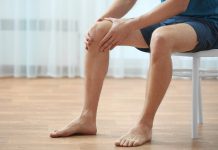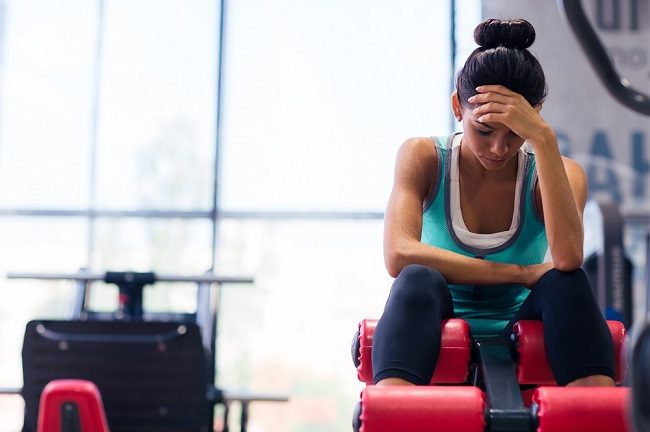Are you working out enough? This is a very common question. But we have a few different ones for you today – are you overworking yourself? Trying to achieve too much in a short time, not taking enough rest, and just going on and on with the same movements? Well, if you answered yes then this article is for you! Because safety comes first and we believe in the phrase ‘prevention is better than cure’. Workout injuries are very common and we understand that dealing with them is a total pain. It doesn’t matter if you’re a pro or a beginner, if you have an injury then it means no workout for at least a day or two! And this is more mentally taxing, especially for those who love their sweat sesh so much.
So here are some of the most common workout injuries and how you can avoid them:
Biceps Tendonitis
It’s an injury that occurs due to overuse of shoulders and upper arms causing inflammation of the tendons around the bicep muscles. It could be due to lifting heavy weights, swimming for long hours continuously and also playing sports like tennis, badminton, and golf! Basically, any continuous, repetitive, overhead motion can cause this injury. It affects the frontier portion of your shoulders and biceps or most of the upper arm regions. This results in visible inflammation in the tendons that run from your upper bicep muscles to the bones to your shoulder blades.
How to avoid it: It is always advised and recommended that you warm up well before any workout. The next thing to do would be to shuffle between your workout activities. Avoid the repetitive movements, especially the overhead ones and ensure you rest enough between the sets. If you’re into swimming then alternate between styles. For tennis, badminton, and golf players rest well and hydrate. Checking your posture every now and then could also help you reduce the risk.
Rotator Cuff Injury
Similar to the bicep tendonitis, rotator cuff injury is also a result of constant overhead arm movements. Your rotator cuffs are the tendons and ligaments that support your arm at the shoulder joint. It also comprises of 4 major muscles – supraspinatus, infraspinatus, teres minor, and subscapularis, and any pain that you experience while swimming continuously or doing military press could be a sign of this injury. The back of your shoulders are the affected areas and movements that need you to stretch backwards or move your hands overhead become increasingly painful during this injury.
How to avoid it: To avoid a rotator cuff injury, you will need to strengthen those 4 muscles. Ensure to include rotator cuff strengthening workouts in your upper body training sessions. Correct your posture and as we said earlier, break between repetitive movements. Don’t slouch your shoulder joints and try the pulldowns in front (to the side of your chest) rather than behind your neck.

Sprains and Pains in the back (upper and lower)
One of the most enfeebling and painful injuries are those of the back – sprains and pains both caused by overworking yourself at the gym! While a back sprain will not even let you move, a strain related pain will leave you breathless and can also affect your neck and hip regions. Lifting heavy weights, squatting, or a combination of the 2 like deadlifts are some workouts you should be extra careful while doing. Some twisting movements and sideways bends are some of those that’ll affect your lower back.
How to avoid it: Learn how to keep a neutral back while performing workouts. Your posture plays a very crucial role. To avoid these sprains and pains further brace yourself while you’re lifting heavy. Don’t even try to jump to super heavy weights in the beginning itself. Take it gradually and go according to your capacity. Another simple step would be to warm up well.
Iliotibial Band Syndrome or IT Band Syndrome
If you’re a runner or a cyclist then you’d probably be very familiar with the IT (iliotibial) band syndrome (ITBS). The ligament that goes all the way from your outer thighs – hips to the shins – are your IT band muscles. Prolonged periods of running and cycling wherein you use these muscles, your legs to be more precise, trigger tightened and inflamed IT band ligaments that cause pain and discomfort. Running on terrains that are downhill, worn out shoes, and running on uneven surfaces are all key reasons for the ITBS; and so is overtraining – running or cycling too many miles at a stretch.
How to avoid it: Depending on your workout, just make sure everything is in your favour. Check your shoes every now and then – ensure they aren’t worn out too much. There are specific shoes for running that you might want to consider. Warm up before starting any workout. Avoid concrete terrains and also if you’re running on a track then keep changing your direction regularly. Cyclist should take care that the seat is not too high or low, and if you’re on an indoor cycle then do not forget to change the settings according to your current fitness levels.
Runner’s knee or Patellofemoral Syndrome
Too much of running, jogging, jumping, and even squatting can result to patellofemoral syndrome which is more commonly known as the runner’s knee. It happens when the bones of your leg (around the knees) are not lined up properly causing an abnormal gliding between the kneecap and the thigh bone (the patella and the femur). This shift in alignment may lead to erosion of the cartilage and bone surfaces. This causes pain in the regions behind your knee caps and are often caused and worsened by sudden increase in intensity of running, getting down a little too many flight of stairs, and sitting in cross legged postures or with bent knees for very long time.
How to avoid it: Working on strengthening your quads and hip flexors is one way you can keep your knees healthy. If needed then you could also use a knee cap or wrap to reduce the impact during high intensity workouts. Rest well between kneeling and squatting workouts.
Shin Splints
Shin splints, also known as the medial tibial stress syndrome and very similar to the ITBS, is another common painful injury. It occurs in the muscles that surround the shin bones (inner edge of your tibia). Shin splints generally happen when there’s a sudden increase in intensity or frequency of high impact workouts like jumping and running long distances, resulting in sore and severely inflamed muscles accompanied by a lot of pain. Running on uneven surfaces, uphill or downhill running, and workout like jumping rope or box jumps could be strenuous to your shins. And of course like ITBS even shin splints are caused by wearing worn out shoes.
How to avoid it: A common solution to this will also be using the right gear; good shoes that is. Running on cushioned terrains and upping your workouts a little at a time are other ways to avoid shin splints. Warm up before your workouts, like walking before you run and light cardio before you begin something that’s more intense will go a long way.

Ankle Sprain
Have you stepped on a pebble and felt a sudden ‘ouch’ come out while experiencing excruciating pain? If yes, then you’ve probably experienced an ankle sprain. Irrespective of whether you are running outdoors or on a treadmill, an ankle sprain is a very common workout injury. You could just lose your concentration or focus while running (both on a treadmill or outdoors) and sprain your ankle. Even a simple misstep while jogging could lead to this and it can get extremely painful . Similar to the other common workout injuries, ankle sprains could also be the result of running or even walking on uneven surfaces and jumping.
How to avoid it: If you’re a treadmill runner then ensure that the speed is not too much and don’t forget to clip the safety clip before beginning. Remember to stay focussed at all times. For the outdoor runners, stay focussed on where you’re running and keep away from uneven surfaces. If you are into high intensity workouts like box jumps, then keep a close watch on your landing.
Need a customized daily diet-plan? Buy now @Rs.1499 only.

You May Also Like: 20 Minute Anytime Anywhere Workout For Your Entire Body
It always pays to be safe than sorry! So, keep these tips in mind while you’re working out next time. Remember 3 very important things – Warm up right, rest between sets, and hydrate well. You’re happy workout session are just a few precautions away. We hope you have a safe and power packed workout session. Until next time, stay healthy and live happy! If you like this article then don’t forget to hit the like button and do share it with your friends too. Your thoughts and feedback are welcome in the comments section below.


 Traqade
Traqade
































These tips will help me in preventing my workout injuries. Being a sportsperson its vey necessary for me to stay away from injuries.
Thank You for the tips! ☺
Based on the player’s decisions, horror games have many different endings. This increases the value and each time you play, it will be a different journey that is not boring.
Beginners to exercise are usually people who don’t know what exercise injuries are, your article gives really great information, I think beginners to exercise should read this article carefully, because when I first started exercising, I also had neck pain and couldn’t exercise for a week, I was very bored for a week, sometimes I tried to relieve my distress by playing basketballlegends game, it works, but I missed exercising a lot during that time.
This blog is exceptional. It was a pleasure to read your articles. This book was exceedingly entertaining for me. I have bookmarked it and am enthusiastic about reading additional content. Maintain your exceptional performance!